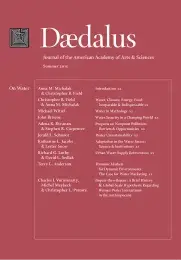Dynamic Markets for Dynamic Environments: The Case for Water Marketing
Static models used in economics and ecology ignore dynamic processes at work in both human and natural systems. In the case of water management, whether for quantity or quality, static models fail to connect changing human demands on water systems with changing supplies due to short-run climate variations and long-run climate change. Water markets provide a way of connecting human demands to nature’s supplies through prices, which signal values and scarcity. For water markets to make this connection, water rights must be well-defined, enforced, and tradeable. When they are, entrepreneurs are able to meet old and new demands on water ecosystems in novel ways, as examples in this essay illustrate.
Analyzing nature and economies as static systems gravitating toward equilibria distracts our attention from the dynamic forces in both. Focusing, instead, on the dynamic processes at work in the environment and in markets provides a link between the two by emphasizing that 1) environmental problems result from a lack of clear property rights; 2) property rights problems are entrepreneurial opportunities; and 3) entrepreneurs respond to and create market signals, which incorporate environmental conditions.
Economics, in general, and environmental economics, in particular, are saddled with static models. Although economic models of market equilibrium provide useful predictions of tendencies toward equilibrium, they do not tell us much about the process of getting there. Natural resource economic models, meanwhile, emphasize the static notion that private costs are often less than social costs. This allows private actors to ignore some costs of their actions and thereby engage in practices that are not beneficial to society: too much fishing of a stock of fish, too many emissions into the air, and too much diversion of water from rivers, for example. The implication, therefore, is that to achieve socially optimal resource use, private action must be curtailed by collective action. This static conclusion fails to recognize that any such divergences result from property rights that are not well-defined and enforced1 and that property rights are continually evolving.2
Just as equilibrium models oversimplify markets and ignore the important dynamic forces of entrepreneurship, environmental models have oversimplified ecological systems and ignored the importance of dynamic organisms. They build on a perspective of natural balance, rather than on ecosystems that are continually confronting and generating new constraints and adjusting to them. In the words of ecologist Daniel Botkin, “We have tended to view nature as a digital camera’s [kodachrome, as he called it] still life, much like a tourist-guide illustration of La Salute; but nature with and without people is and always has been a moving-picture show, much like the continually changing and complex patterns of the water in the Venetian lagoon.”3 Botkin asks, “How real is the concept of a balance of Nature? What is the connection between people and nature? What are our roles in and obligations to nature?”4
. . .
Endnotes
- 1See Ronald H. Coase, “The Problem of Social Cost,” Journal of Law and Economics 3 (October 1960): 1–44.
- 2See Harold Demsetz, “Toward a Theory of Property Rights,” American Economic Review: Papers and roceedings 57 (2): 347–359; and Terry L. Anderson and Peter J. Hill, “The Evolution of Property Rights: A Study of the American West,” Journal of Law and Economics 18 (1): 163–179.
- 3Daniel B. Botkin, The Moon in the Nautilus Shell: Discordant Harmonies Revisited (Oxford: Oxford University Press, 2012), 3.
- 4Ibid., 18.
